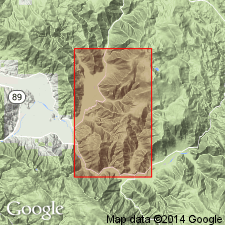
- Usage in publication:
-
- Combe formation
- Modifications:
-
- Original reference
- Biostratigraphic dating
- Dominant lithology:
-
- Sandstone
- Conglomerate
- AAPG geologic province:
-
- Sierra Nevada province
Summary:
Pg. 896, 903. Combe formation (also referred to as Combe sandstone). Consists of calcareous marine sandstone and conglomerate containing cobbles from the middle Late Jurassic quartz porphyry and from granitic plutons. Thickness 550 feet. Contains rich but ill-preserved fauna [list included]. Overlies Trail tuff and conglomerate (Trail formation). Age is late Late Jurassic (Tithonian).
Type locality: Combe Canyon, north of Mount Jura, [Plumas Co.], northern CA. Named from Combe Canyon.
Source: US geologic names lexicon (USGS Bull. 896, p. 498-499); supplemental information from GNU records (USGS DDS-6; Menlo GNULEX).

- Usage in publication:
-
- Combe Formation
- Modifications:
-
- Not used
- AAPG geologic province:
-
- Sierra Nevada province
Summary:
"Combe Formation of Crickmay [1933] has not yet been identified." p.182. [Trail Formation is shown as uppermost formation in Jurassic section on Mount Jura.]
Source: GNU records (USGS DDS-6; Menlo GNULEX).
For more information, please contact Nancy Stamm, Geologic Names Committee Secretary.
Asterisk (*) indicates published by U.S. Geological Survey authors.
"No current usage" (†) implies that a name has been abandoned or has fallen into disuse. Former usage and, if known, replacement name given in parentheses ( ).
Slash (/) indicates name conflicts with nomenclatural guidelines (CSN, 1933; ACSN, 1961, 1970; NACSN, 1983, 2005, 2021). May be explained within brackets ([ ]).

